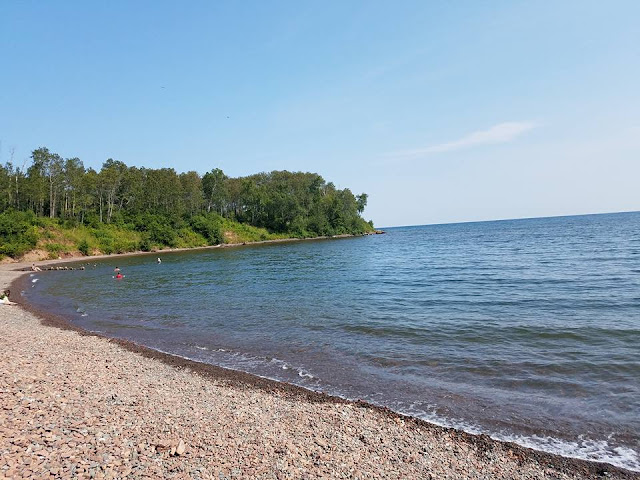We left Finland and headed north along Lake Superior, the largest and deepest of the great lakes. What the Ojibwa called Lake Gichigami.
We could see Isle Royal National Park between the small island and the peninsula of the left. It does not appear in the picture.
Grand Portage was an outpost for the British North West Company while they sent trappers out into the bush for the infamous beaver pelts used to make hats in Europe. Grand Portage is so named for the 8.5 mile trail running from Fort Williams on Lake Superior to Fort Charlotte on the Pigeon River. This portage bypassed twenty miles of the Pigeon River and the many rapids and waterfalls along the way.
The British and the Indians got along very well and the Indians called these men the French word, voyageurs. They transported goods to Fort Charlotte and furs back to Fort Williams. After the War of 1812 ended, the border was moved to the Pigeon River about twelve miles north of Fort Williams. The British packed up and moved to Thunder Bay in Ontario. After the British left, the Indians referred to these as the lean years because their source of goods and trade had left.
Today, you can hike the 8.5 miles of the portage and enjoy the wilderness protected in the Boundary Waters Canoe area and Voyageurs National Park.
More dead straight roads on the way to Duluth.
A short stop on the trip down.
August 15
It was rainy and foggy when we got up. It was chilly as well. Our first stop was the S.S. Meteor, a whale back ship on dry land in Superior, WI. The last of Captain Alexander McDougall’s American Barge Company's small fleet. I had been here when I was ten and still have a glass mug from the place.
Across the street from the SS Meteor is the Fairlawn Mansion, a Queen Ann Victorian house built by Martin Pattison, a mining and timber baron, in 1891 for $150,000, roughly 4 million in today's money. The first and second floors of the mansion has been fully restored and the third floor is dedicated to the time when it was a children's home. At the time the home was built, it had unobstructed views of Lake Superior. The bottom floor is accessible but not the uppers.
Legend has it that Pattison and local dredge operator Charlie Barker had a feud about the price of lumber. Barker claimed Pattison always raised the price when Barker needed timber. So in retaliation, Barker began to dump his dredgings in front of Fairlawn and eventually the leavings created what is now known as Barker's island. In all likelyhood, this was just a bit of local color and the real reason Barker dumped there was because he was too cheap to ship the sand and mud away by train or to spend the time to take it out into Superior to dump it.
From there we crossed back to Duluth and went downtown to find something to eat. We stopped at Famous Dave's BBQ. It was raining heavily when we got there and kept spitting after we came out. We drove down the street to Lake Superior Maritime Museum beside the Aerial Lift Bridge. The best thing about the small museum is that its free!
A ship's engine. This is a twin cylinder.
Another engine. I was fascinated by the blow torches used to preheat the cylinder heads.
There were lots of models in the museum.
A model showing a ship at the coal pier. They took the time to show how the coaling piers worked as well as how the massive grain silos that dominate the Superior/Duluth waterfront operate.
Looking down in the engine.
The Ariel Lift Bridge. The bottom lifts straight up so that ships can pass underneath it. We drove across the bridge(w/o the trailer). It was a tight fit.
In the museum, I came across a pamphlet for Duluth's Skyline Parkway. I'm always up for a drive on a scenic route. This road was the vision of William K Rogers and work started on the road in 1889. The twenty-five road was finished in 1929. We were looking for the start of the road and saw some beautiful houses including this one with the massive lion head on the upper balcony railing.
One of the big attractions along the Skyline Parkway is Enger Tower and Park. The tower is an eighty foot high, five-story octagon. It sits on a ridge 451 feet above Lake Superior giving a commanding view of the lake, Duluth, Superior, and beyond. Unfortunately, it was a little rainy and fog was starting to roll in. The tower is not accessible but Becky and Patrick braved the weather and got some breathtaking shots.
We made our way back to Buffalo Valley Campground with a stop at the grocery store along the way.







































No comments:
Post a Comment